Eco-Environmental Quality Assessment Using the Remote Sensing Ecological Index in Suzhou City, China
Abstract
:1. Introduction
2. Materials and Methods
2.1. Study Area
2.2. Data Source and Preprocessing
2.3. Construction of the RSEI
- (1)
- Wetness Index
- (2)
- Greenness Index
- (3)
- Dryness Index
- (4)
- Heat Index
- (5)
- Normalization of Indicators
3. Results and Analysis
3.1. Results of the Four Indicators and RSEI
3.2. Temporal Changes in the EEQ of Suzhou City
3.3. Spatial Changes in the EEQ of Suzhou City
3.4. Spatiotemporal Differences in the EEQ of Suzhou City
4. Conclusions
Author Contributions
Funding
Institutional Review Board Statement
Informed Consent Statement
Data Availability Statement
Conflicts of Interest
References
- Zhang, J.; Yang, L.P.; Gong, E.J.; Wang, Y.; Ren, J.; Liu, M. Dynamic monitoring of eco-enviromental quality in Xi’an based on GEE and adjusted RSEI. Acta Ecol. Sin. 2023, 5, 2114–2127. [Google Scholar]
- Zhao, G.Q.; Chen, L.W.; Mu, J.; Li, T.X.; Li, J.P.; Ma, Y.M.; Qu, X.M.; Wang, Y. Discussion on construction of ecological environment quality evaluation system. Meteorol. Environ. Sci. 2018, 1, 1–11. [Google Scholar]
- Nong, L.P.; Wang, J.L.; Yu, Y.H. Research on ecological environment quality in central Yunnan based on MRSEI model. J. Ecol. Rural Environ. 2021, 8, 972–982. [Google Scholar]
- Li, S.Z.; Xue, H.Z.; Li, J.R.; Zhou, L.J.; Gu, J.H.; Dong, G.T. Study on the ecological environment quality change in Hetao irrigation area with remote sensing ecology index. Ecol. Sci. 2022, 3, 156–165. [Google Scholar]
- Li, J.; Zhong, Q.; Zhang, Y. Evaluation of ecological environment in Karst Mountains based on RSEI: Taking Sinan County as an Example. Geomat. Spat. Inf. Technol. 2023, 6, 136–147. [Google Scholar]
- Luo, M.S.Y.; Tao, R.; Zhang, C.F.; Chen, X.F. Study on the ecological environment change in Yichang City based on remote sensing ecological index. Geospat. Inf. 2022, 5, 12–17. [Google Scholar]
- Wang, Y.; Wang, S.D. Dynamic change analysis of ecological quality based on RSEI: A case study of the Danjiang river basin (Henan section). Sci. Soil Water Conserv. 2019, 3, 57–65. [Google Scholar]
- Zhang, W.; Du, P.J.; Guo, S.C.; Lin, C.; Zheng, H.R.; Fu, P.J. Enhanced remote sensing ecological index and ecological environment evaluation in arid area. Natl. Remote Sens. Bull. 2023, 2, 299–317. [Google Scholar] [CrossRef]
- DeVries, B.; Verbesselt, J.; Kooistra, L.; Herold, M. Robust monitoring of small-scale forest disturbances in a tropical montane forest using Landsat time series. Remote Sens. Environ. 2015, 161, 107–121. [Google Scholar] [CrossRef]
- State Environmental Protection Administration of China. Technical Criterion for Eco-Environmental Status Evaluation; HJ/T 192-2006; China Environmental Science Press: Beijing, China, 2006.
- Ministry of Ecology and Environment of the People’s Republic of China. Technical Criterion for Ecosystem Status Evaluation; HJ 192-2015; China Environmental Science Press: Beijing, China, 2015.
- Zhou, M.; Liu, Y.C.; Meng, L.H.; Jiao, K.Q.; Li, Q.; Zou, X.Y. Evaluation of ecological environment quality of Dongjiang River headwaters based on remote sensing ecological index during 2000–2019. Bull. Soil Water Conserv. 2021, 4, 231–240. [Google Scholar]
- Zhang, Y.Q.; Jiang, F.; Ji, M.D.; Jiang, H.S.; Wang, Z.Y. Assessment of the ecological environment at district and county level based on remote sensing index. Arid Zone Res. 2020, 6, 1598–1605. [Google Scholar]
- Liang, Q.L.; Shi, Z.T.; Chen, Y.H.; He, G.X.; Shi, L.T.; Li, J. Ecological environmental dynamic monitoring and driving force analysis of based on remote sensing ecological index. Bull. Soil Water Conserv. 2022, 6, 146–154. [Google Scholar]
- Xu, H.Q. A remote sensing urban ecological index and its application. Acta Ecol. Sin. 2013, 24, 7853–7862. [Google Scholar]
- Runge, A.; Nitze, I.; Grosse, G. Remote sensing annual dynamics of rapid permafrost thaw disturbances with LandTrendr. Remote Sens. Environ. 2022, 268, 112752. [Google Scholar] [CrossRef]
- Hu, K.; Han, N.L.; Yu, M.; Zhang, Y.C. Land use change simulation in Sanya city based on remote sensing ecological index. Sci. Soil Water Conserv. 2023, 1, 101–109. [Google Scholar]
- Yue, H.; Liu, Y.; Li, Y.; Lu, Y. Eco-environmental quality assessment in China’s 35 major cities based on remote sensing ecological index. IEEE Access 2019, 7, 51295–51311. [Google Scholar] [CrossRef]
- Hu, X.S.; Xu, H.Q. A new remote sensing index for assessing the spatial heterogeneity in urban ecological quality: A case from Fuzhou city, China. Ecol. Indic. 2018, 89, 11–21. [Google Scholar] [CrossRef]
- Wang, D.C.; Chen, X.; Sun, Z.C.; Xin, Y.; Wang, H.Q.; Chai, H.; Wang, H.Y. Monitoring of changes in the ecological index of long-time sequence remote sensing in Golmud, Qinghai Province. Acta Ecol. Sin. 2022, 14, 5922–5933. [Google Scholar]
- Boori, M.; Choudhary, K.; Paringer, R.; Kupriyanov, A. Spatiotemporal ecological vulnerability analysis with statistical correlation based on satellite remote sensing in Samara, Russia. J. Environ. Manag. 2021, 285, 112138. [Google Scholar] [CrossRef]
- Saleh, S.; Amoushahi, S.; Gholipour, M. Spatiotemporal ecological quality assessment of metropolitan cities: A case study of central Iran. Environ. Monit. Assess. 2021, 193, 305. [Google Scholar] [CrossRef]
- Miao, X.H.; Liang, Q.O. Analysis of ecological environment changes in Yongjiang river basin based on remote sensing ecological index. Resour. Environ. Yangtze Basin 2021, 2, 427–438. [Google Scholar]
- Chen, F.; Qiao, G.T.; Zhang, D.D.; Wang, N. Evaluation of ecological environment quality and diagnosis of obstacle factors in Suzhou. J. Nanyang Inst. Technol. 2022, 4, 44–49. [Google Scholar]
- The People’s Government of Suzhou Municipality. Physical Geography. 2023. Available online: https://www.ahsz.gov.cn/zjsz/zrdl/index.html (accessed on 12 June 2023).
- The United States Geological Survey (USGS). Available online: https://earthexplorer.usgs.gov (accessed on 4 March 2023).
- Quan, W.T.; Zhang, S.Y.; Liu, Y.; Wang, W.D. Monitoring and evaluation of ecological environment changes in Dongzhuang reservoir basin in Shaanxi Province based on remote sensing ecological index. Bull. Soil Water Conserv. 2022, 5, 96–104. [Google Scholar]
- Turner, M.G. Landscape ecology: The effect of pattern on process. Annu. Rev. Ecol. Syst. 1989, 20, 171–197. [Google Scholar] [CrossRef]
- Wang, Z.C.; He, X.H. Assessments of ecological quality in Jinjiang district of Chengdu city using the FVC and RSEI models. J. Ecol. Rural Environ. 2021, 4, 492–500. [Google Scholar]
- Fang, G.; Deng, D.B. Temporal and spatial change analysis of urban heat island effect in Suzhou. J. Suzhou Univ. 2022, 3, 59–63. [Google Scholar]
- Qin, Z.H.; Li, W.J.; Xu, B.; Chen, Z.X.; Liu, J. The estimation of land surface emissivity for Landsat TM6. Remote Sens. Land Resour. 2004, 3, 28–32, 36, 41. [Google Scholar]
- Zhang, W.Q.; Sun, C.J.; Li, X.G. Vegetation cover change and ecological effect assessment in the loess plateau of southwest Shanxi Province based on remote sensing image. J. Nat. Resour. 2019, 8, 1748–1758. [Google Scholar] [CrossRef]
- Sun, G.J.; Li, X.M.; Zhang, W.Q.; Chen, W.; Wang, J.R. Evaluation of ecological security in Poverty-stricken region of Lüliang mountain based on the remote sensing image. China Environ. Sci. 2019, 12, 5352–5360. [Google Scholar]
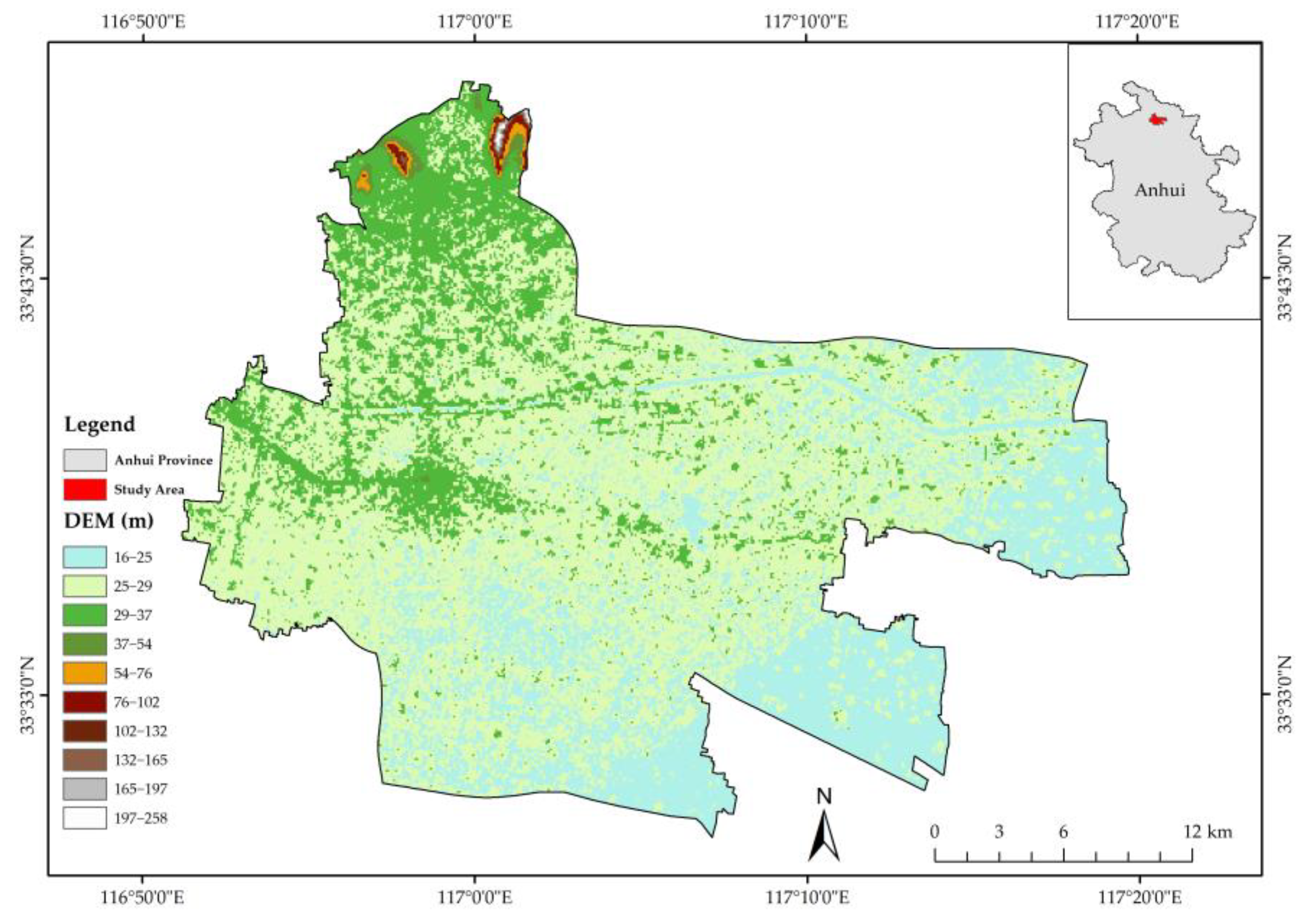
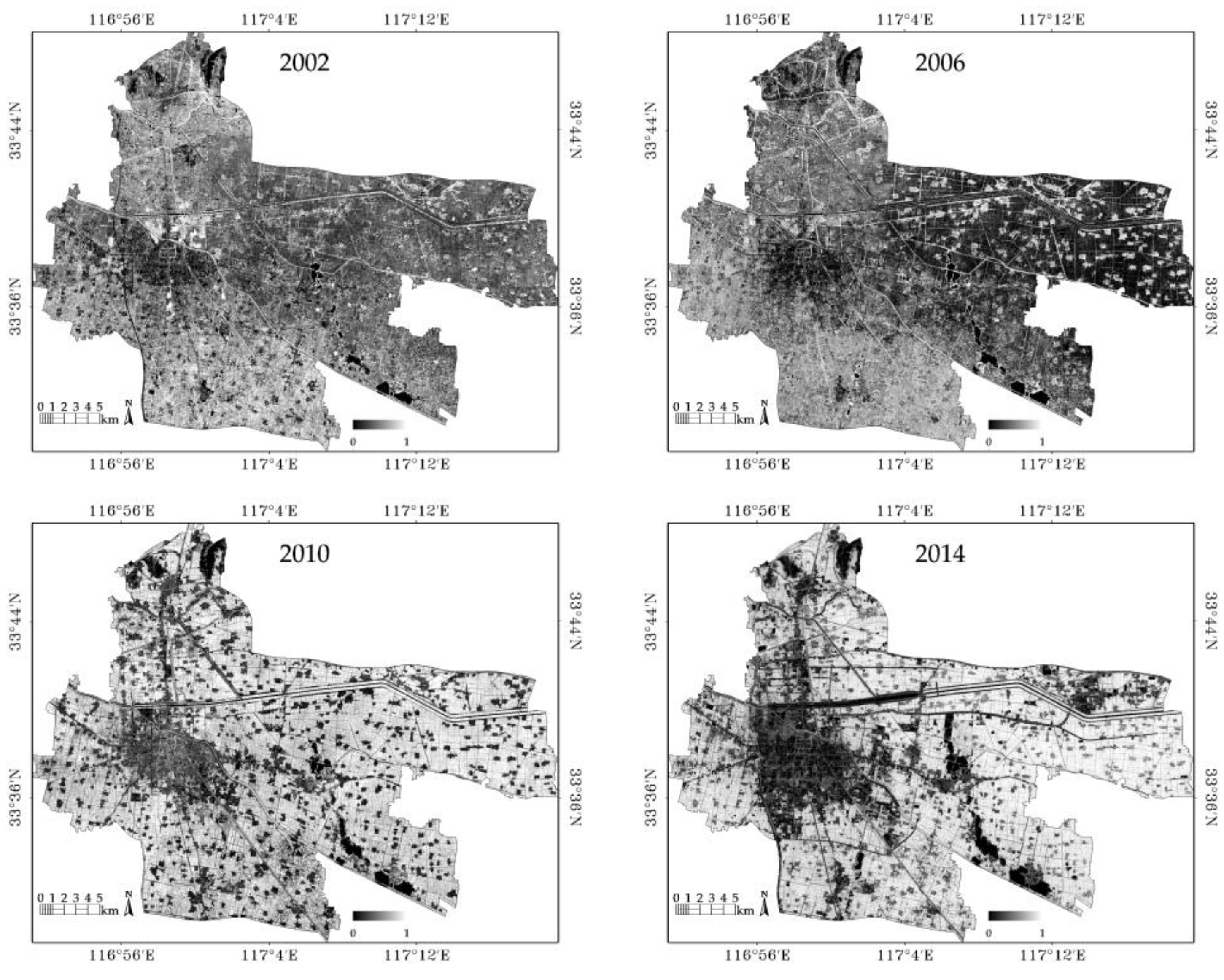

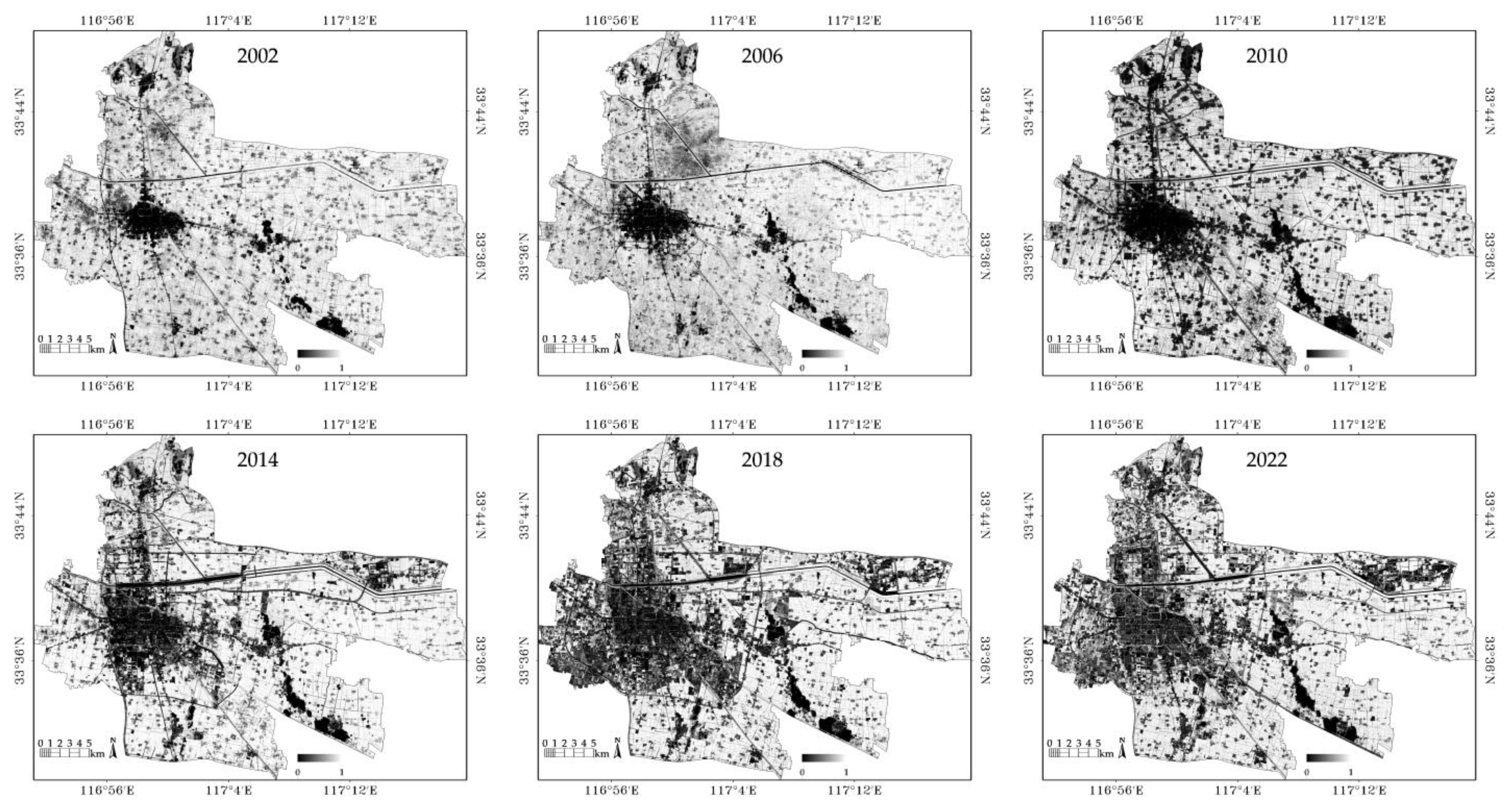

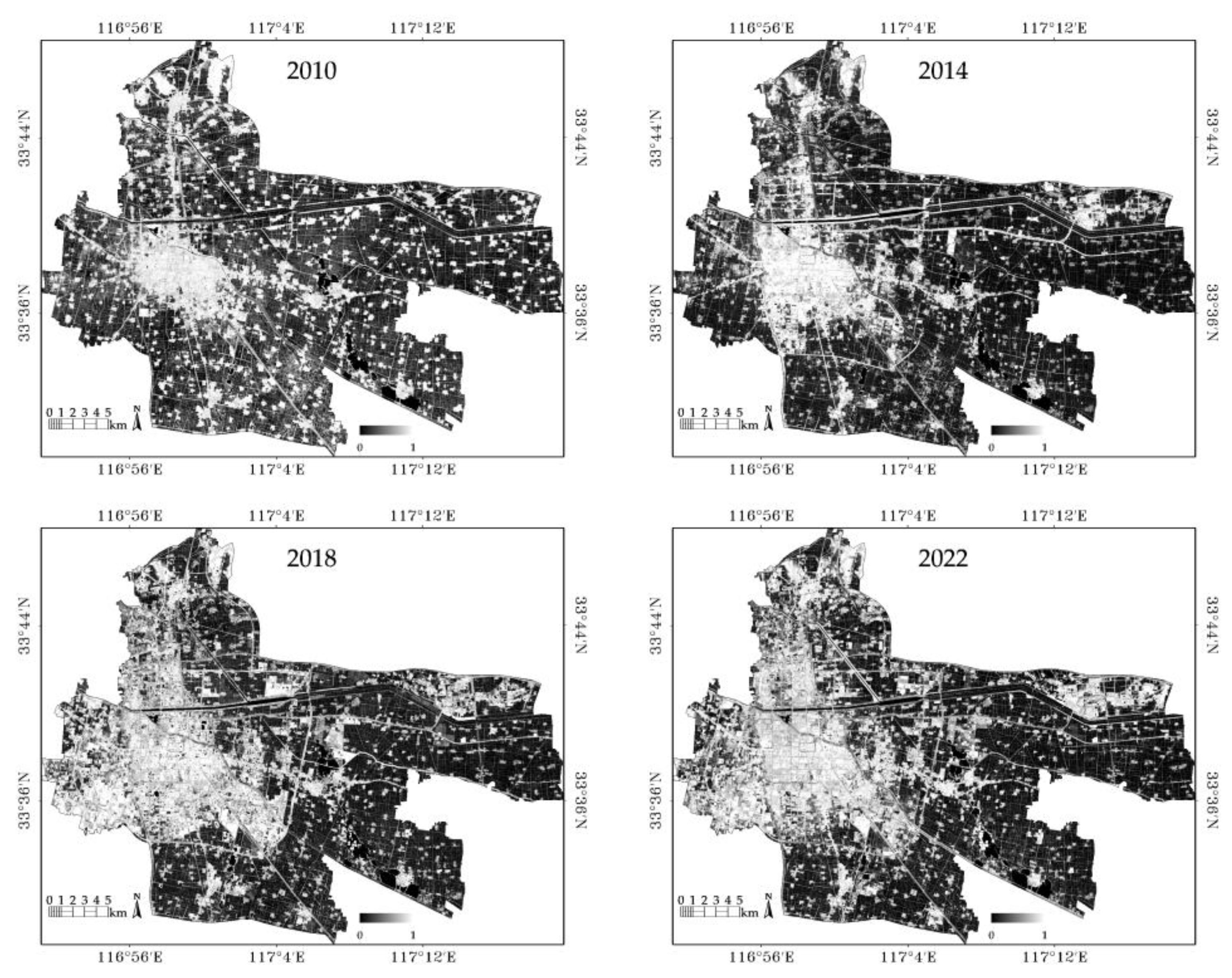
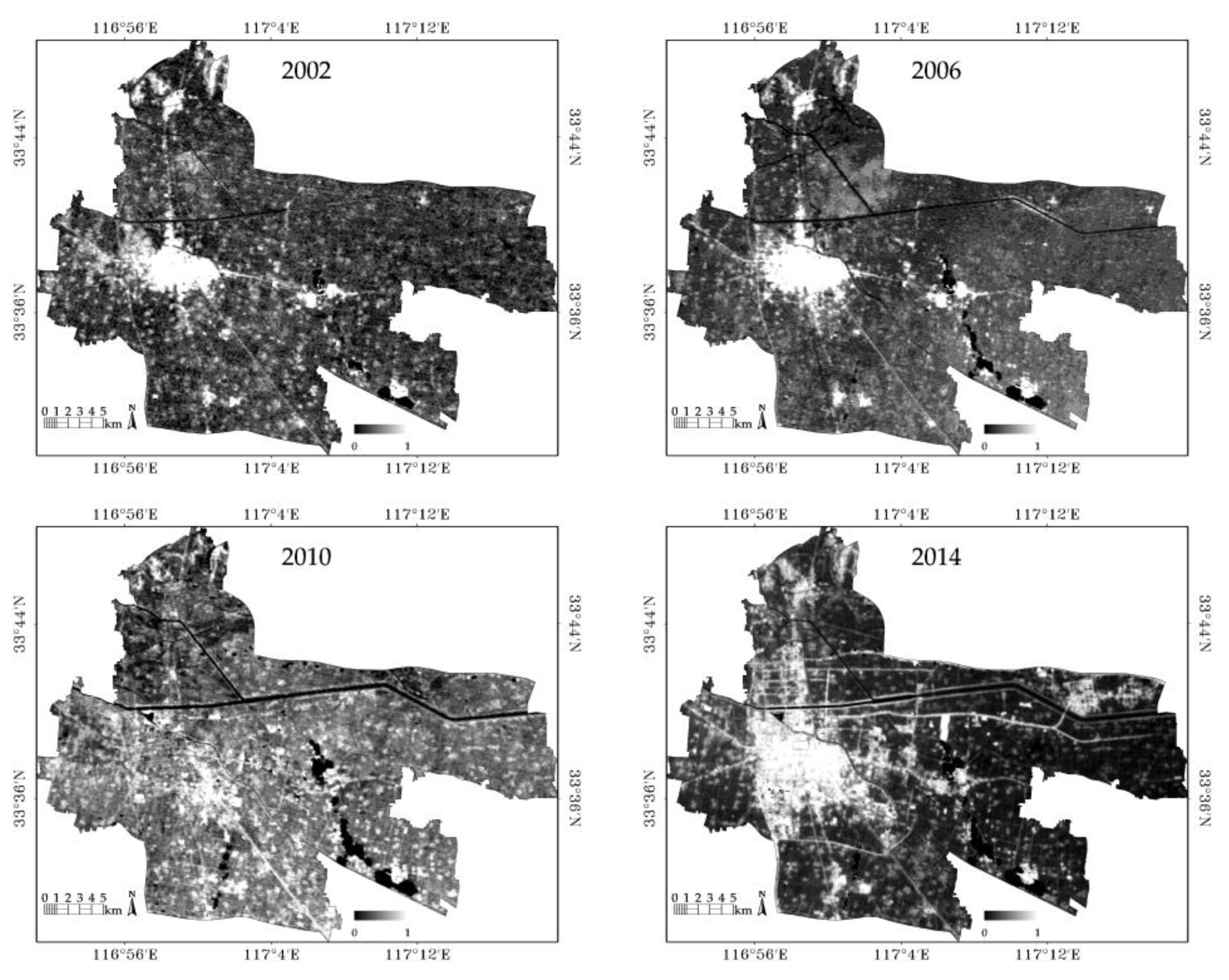
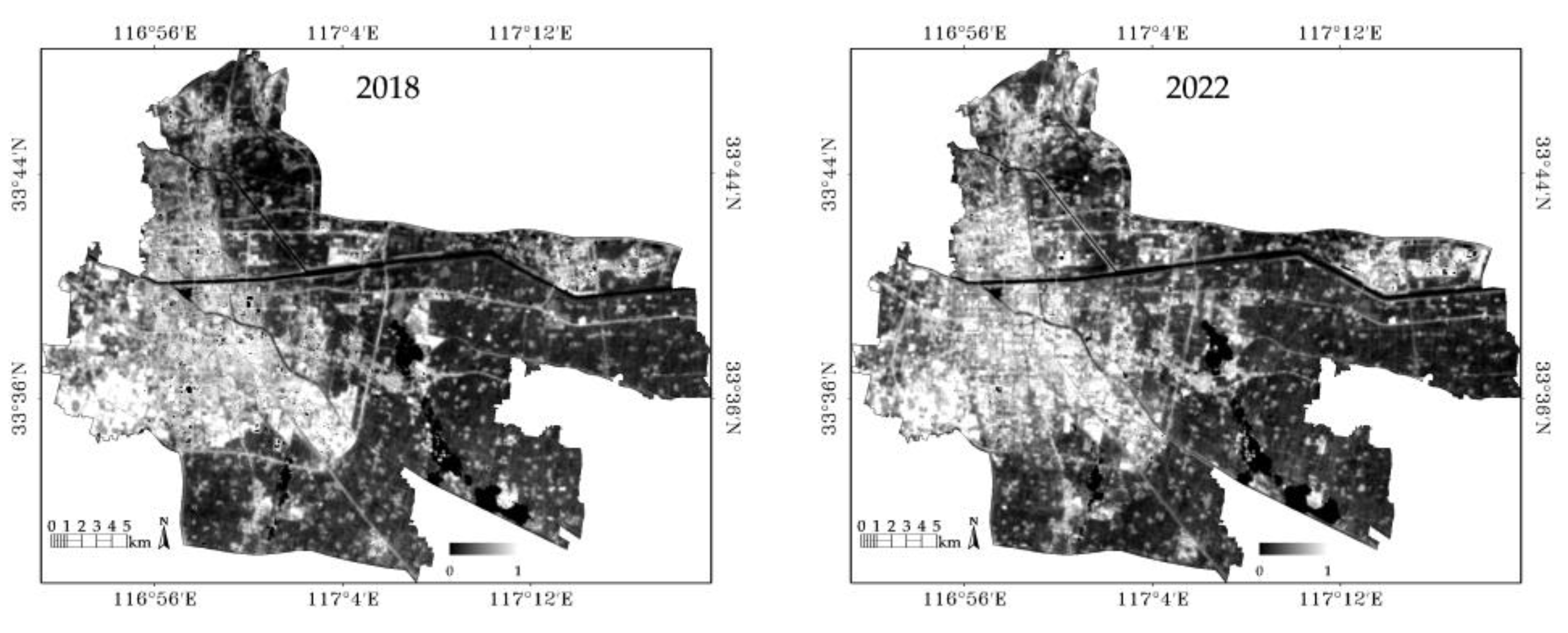
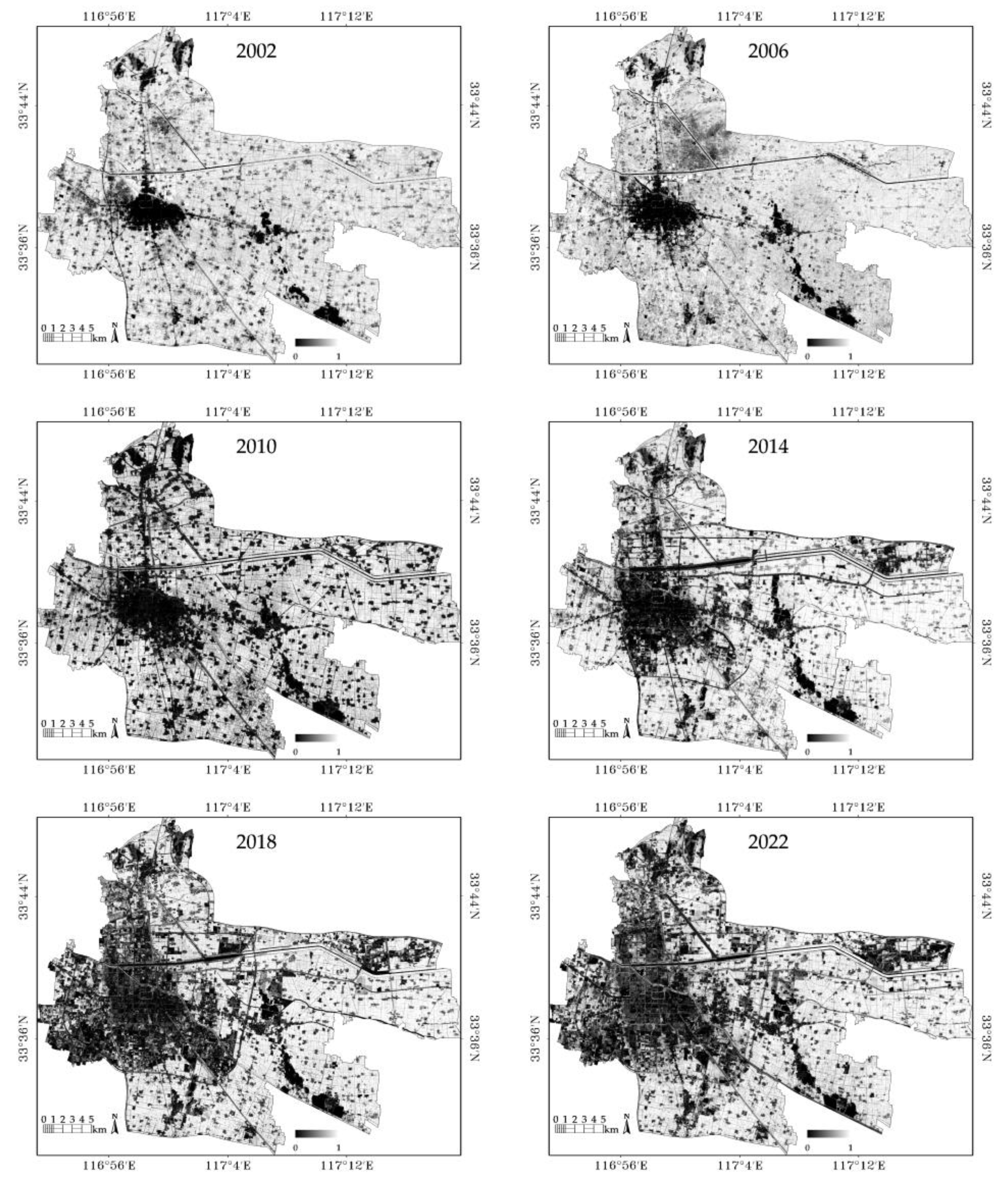
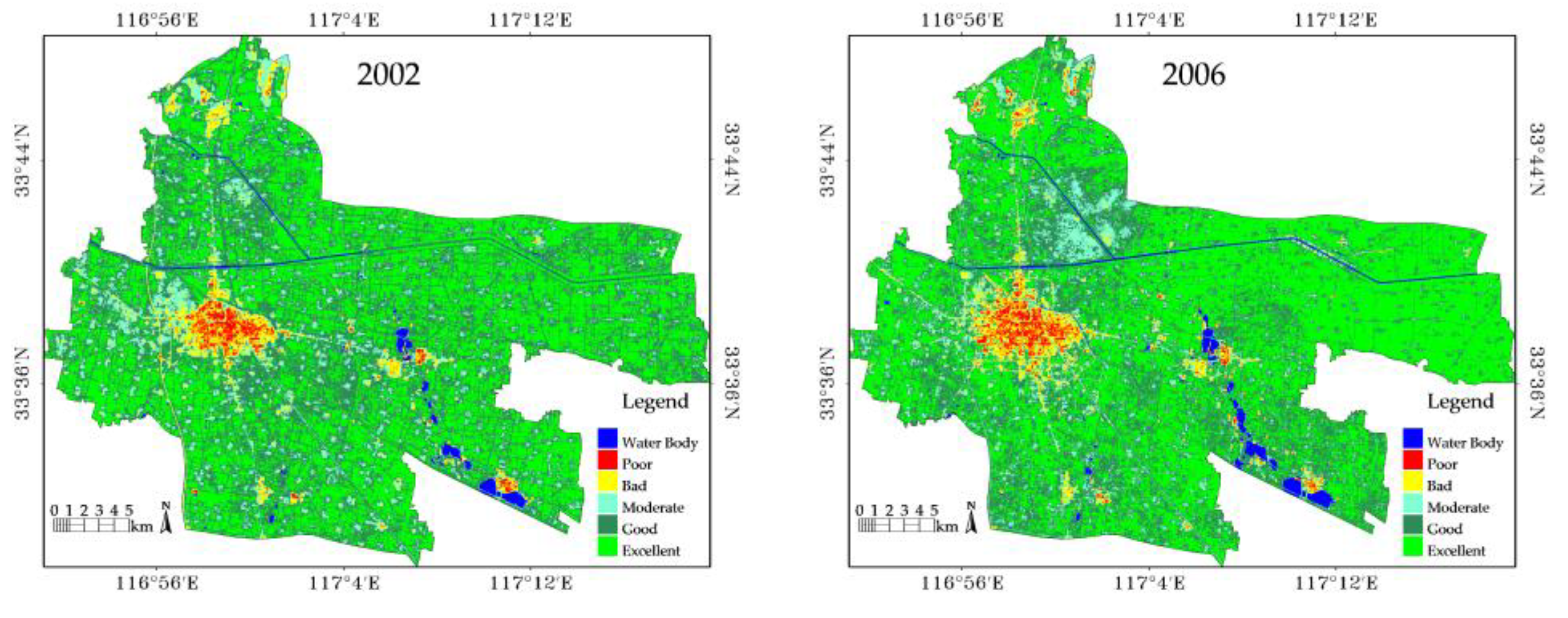
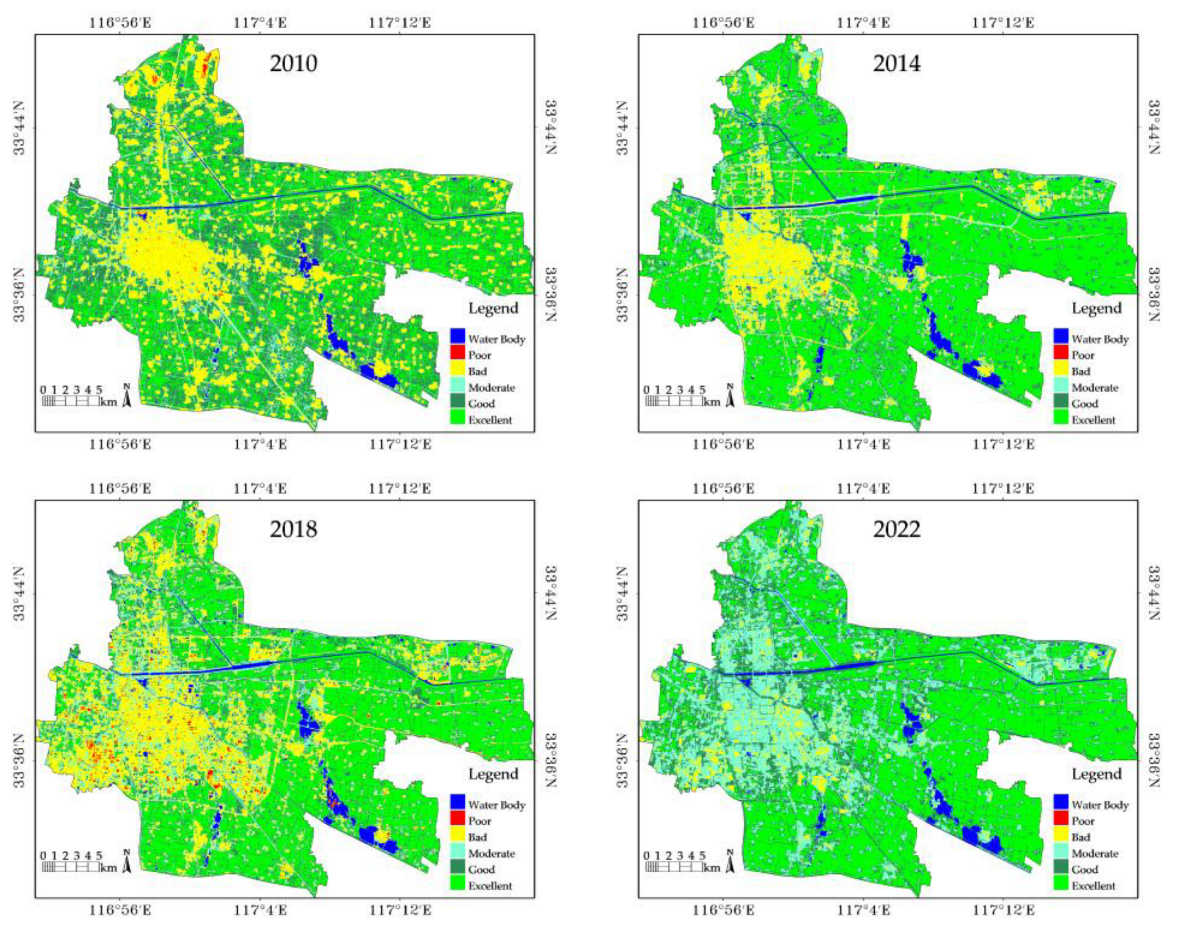
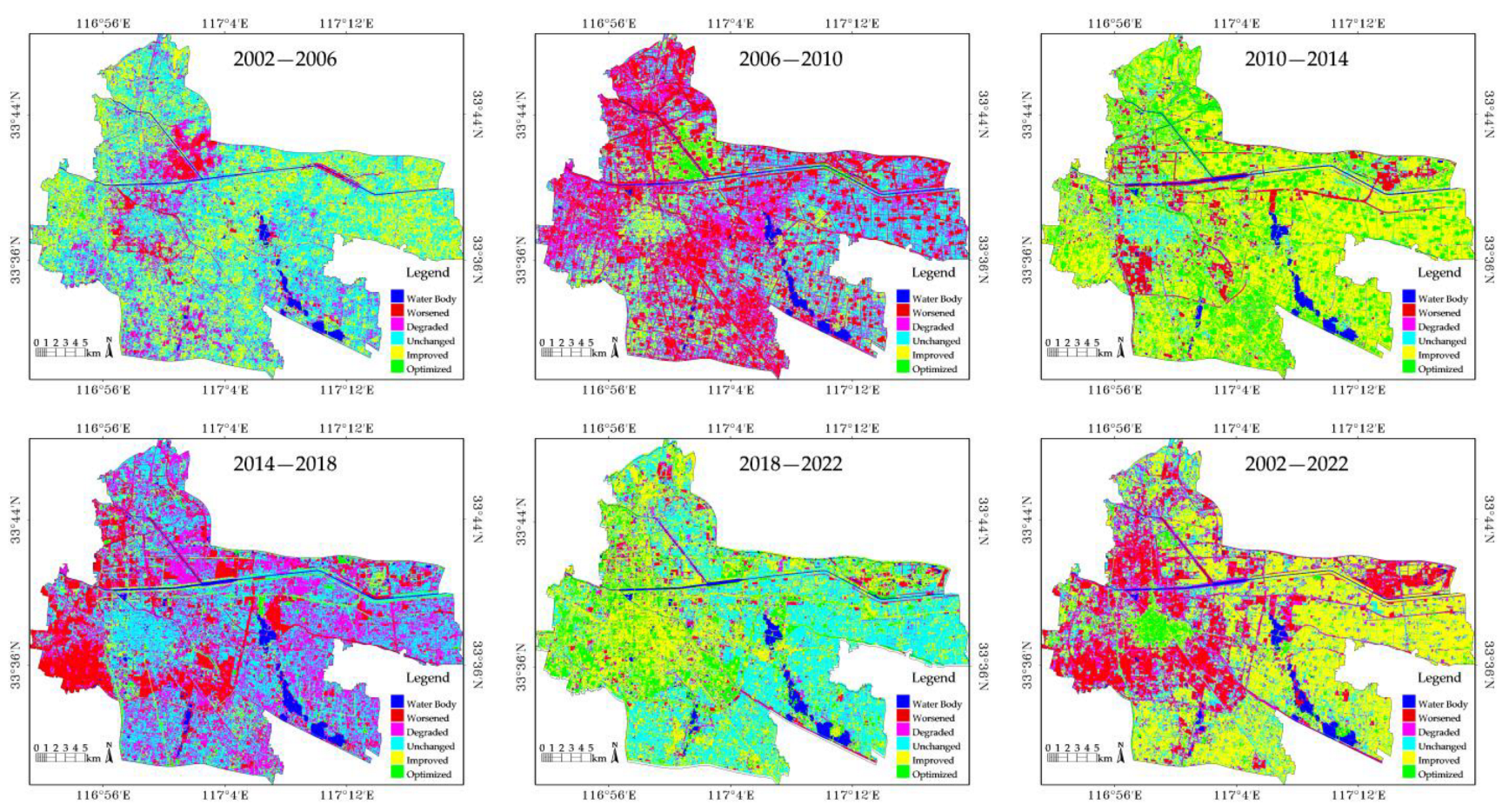
| Years | Satellite/Sensor | Time | Cloud (%) |
|---|---|---|---|
| 2002 | Landsat 5/TM | 4 August 2002 | 1 |
| 2006 | Landsat 5/TM | 30 July 2006 | 0 |
| 2010 | Landsat 5/TM | 19 March 2010 | 2 |
| 2014 | Landsat 8/OLI and TIRS | 1 May 2014 | 0.28 |
| 2018 | Landsat 8/OLI and TIRS | 10 April 2018 | 0.58 |
| 2022 | Landsat 8/OLI and TIRS | 21 April 2022 | 0.09 |
| Sensor Type | Gain | Bias | K1 (W·(m2∙sr·μm)−1) | K2 (K) |
|---|---|---|---|---|
| TM | 5.5375 × 10−2 | 1.18243 | 607.76 | 1260.56 |
| TIRS | 3.342 × 10−4 | 0.1 | 774.89 | 1321.08 |
| Type | 2002 | 2006 | 2010 | 2014 | 2018 | 2022 |
|---|---|---|---|---|---|---|
| T | 0.42 | 0.35 | 0.81 | 0.85 | 0.85 | 0.83 |
| L↑ | 4.76 | 5.04 | 1.37 | 1.13 | 1.02 | 1.26 |
| L↓ | 6.69 | 7.12 | 2.22 | 1.89 | 1.70 | 2.10 |
| Years | Index | Mean | Standard Deviation | PC1 Loads |
|---|---|---|---|---|
| 2002 | WET | 0.815 | 0.036 | 0.099 |
| NDVI | 0.868 | 0.110 | 0.697 | |
| NDBSI | 0.522 | 0.084 | −0.544 | |
| LST | 0.375 | 0.085 | −0.455 | |
| RSEI | 0.735 | 0.145 | ||
| 2006 | WET | 0.837 | 0.042 | 0.022 |
| NDVI | 0.827 | 0.151 | 0.759 | |
| NDBSI | 0.419 | 0.113 | −0.576 | |
| LST | 0.377 | 0.077 | −0.302 | |
| RSEI | 0.746 | 0.160 | ||
| 2010 | WET | 0.762 | 0.072 | 0.230 |
| NDVI | 0.689 | 0.207 | 0.679 | |
| NDBSI | 0.387 | 0.200 | −0.687 | |
| LST | 0.563 | 0.074 | −0.117 | |
| RSEI | 0.632 | 0.217 | ||
| 2014 | WET | 0.839 | 0.102 | 0.288 |
| NDVI | 0.739 | 0.236 | 0.640 | |
| NDBSI | 0.288 | 0.215 | −0.616 | |
| LST | 0.292 | 0.147 | −0.359 | |
| RSEI | 0.744 | 0.224 | ||
| 2018 | WET | 0.816 | 0.077 | 0.217 |
| NDVI | 0.669 | 0.230 | 0.667 | |
| NDBSI | 0.377 | 0.222 | −0.663 | |
| LST | 0.412 | 0.110 | −0.261 | |
| RSEI | 0.639 | 0.246 | ||
| 2022 | WET | 0.758 | 0.105 | 0.450 |
| NDVI | 0.812 | 0.144 | 0.611 | |
| NDBSI | 0.329 | 0.115 | −0.513 | |
| LST | 0.304 | 0.108 | −0.402 | |
| RSEI | 0.715 | 0.188 |
| Years | Grade | Poor | Bad | Moderate | Good | Excellent | Water Body |
|---|---|---|---|---|---|---|---|
| 2002 | Area (km2) | 8.22 | 29.42 | 75.12 | 315.09 | 347.92 | 9.23 |
| Ratio (%) | 1.05 | 3.75 | 9.57 | 40.13 | 44.32 | 1.18 | |
| 2006 | Area (km2) | 11.34 | 31.89 | 71.24 | 262.93 | 393.87 | 13.73 |
| Ratio (%) | 1.44 | 4.06 | 9.08 | 33.49 | 50.18 | 1.75 | |
| 2010 | Area (km2) | 1.57 | 179.56 | 101.08 | 256.65 | 230.18 | 15.96 |
| Ratio (%) | 0.2 | 22.88 | 12.88 | 32.69 | 29.32 | 2.03 | |
| 2014 | Area (km2) | 0.33 | 98.47 | 105.98 | 126.54 | 432.08 | 21.60 |
| Ratio (%) | 0.04 | 12.55 | 13.5 | 16.12 | 55.04 | 2.75 | |
| 2018 | Area (km2) | 6.73 | 183.95 | 131.46 | 133.15 | 304.64 | 25.07 |
| Ratio (%) | 0.86 | 23.43 | 16.75 | 16.96 | 38.81 | 3.19 | |
| 2022 | Area (km2) | 0.02 | 32.77 | 216.64 | 173.60 | 341.41 | 20.56 |
| Ratio (%) | 0 | 4.17 | 27.61 | 22.11 | 43.49 | 2.62 |
| Years | Grade | Worsened | Degraded | Unchanged | Improved | Optimized | Water Body |
|---|---|---|---|---|---|---|---|
| 2002–2006 | Area (km2) | 29.77 | 112.11 | 372.44 | 242.06 | 13.87 | 14.75 |
| Ratio (%) | 3.79 | 14.28 | 47.44 | 30.84 | 1.77 | 1.88 | |
| 2006–2010 | Area (km2) | 205.58 | 235.02 | 227.46 | 83.51 | 15.56 | 17.87 |
| Ratio (%) | 26.19 | 29.94 | 28.98 | 10.64 | 1.98 | 2.28 | |
| 2010–2014 | Area (km2) | 51.11 | 31.83 | 95.36 | 398.35 | 185.35 | 23.00 |
| Ratio (%) | 6.51 | 4.05 | 12.15 | 50.75 | 23.61 | 2.93 | |
| 2014–2018 | Area (km2) | 140.15 | 264.01 | 288.74 | 45.29 | 17.02 | 29.79 |
| Ratio (%) | 17.85 | 33.63 | 36.78 | 5.77 | 2.17 | 3.79 | |
| 2018–2022 | Area (km2) | 23.44 | 43.09 | 298.81 | 276.86 | 113.27 | 29.53 |
| Ratio (%) | 2.99 | 5.49 | 38.06 | 35.27 | 14.43 | 3.76 | |
| 2002–2022 | Area (km2) | 134.18 | 125.21 | 155.84 | 310.46 | 36.56 | 22.75 |
| Ratio (%) | 17.09 | 15.95 | 19.85 | 39.55 | 4.66 | 2.90 |
Disclaimer/Publisher’s Note: The statements, opinions and data contained in all publications are solely those of the individual author(s) and contributor(s) and not of MDPI and/or the editor(s). MDPI and/or the editor(s) disclaim responsibility for any injury to people or property resulting from any ideas, methods, instructions or products referred to in the content. |
© 2023 by the authors. Licensee MDPI, Basel, Switzerland. This article is an open access article distributed under the terms and conditions of the Creative Commons Attribution (CC BY) license (https://creativecommons.org/licenses/by/4.0/).
Share and Cite
Fang, G.; Pablo, R.D.A., II; Zhang, Y. Eco-Environmental Quality Assessment Using the Remote Sensing Ecological Index in Suzhou City, China. Sustainability 2023, 15, 13158. https://doi.org/10.3390/su151713158
Fang G, Pablo RDA II, Zhang Y. Eco-Environmental Quality Assessment Using the Remote Sensing Ecological Index in Suzhou City, China. Sustainability. 2023; 15(17):13158. https://doi.org/10.3390/su151713158
Chicago/Turabian StyleFang, Gang, Renato Dan A. Pablo, II, and Yin Zhang. 2023. "Eco-Environmental Quality Assessment Using the Remote Sensing Ecological Index in Suzhou City, China" Sustainability 15, no. 17: 13158. https://doi.org/10.3390/su151713158
APA StyleFang, G., Pablo, R. D. A., II, & Zhang, Y. (2023). Eco-Environmental Quality Assessment Using the Remote Sensing Ecological Index in Suzhou City, China. Sustainability, 15(17), 13158. https://doi.org/10.3390/su151713158






